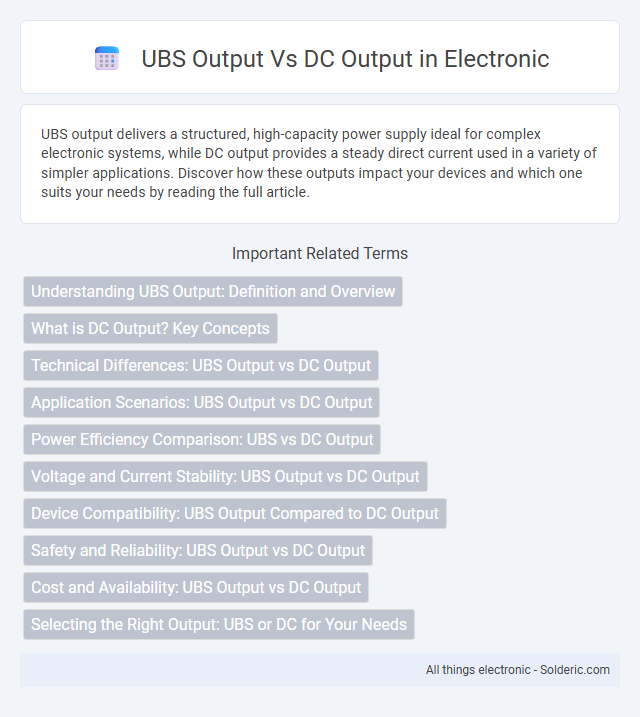UBS output delivers a structured, high-capacity power supply ideal for complex electronic systems, while DC output provides a steady direct current used in a variety of simpler applications. Discover how these outputs impact your devices and which one suits your needs by reading the full article.
Comparison Table
| Feature | UBS Output | DC Output |
|---|---|---|
| Definition | Uninterruptible Power Supply output providing stable, clean power. | Direct Current output delivering consistent voltage and current. |
| Voltage Type | Alternating Current (AC) | Direct Current (DC) |
| Power Stability | High stability with battery backup during outages. | Stable, continuous DC power without conversion. |
| Use Case | Powering sensitive electronics and critical systems. | Powering DC devices, charging batteries, and electronics. |
| Conversion | Converts DC battery power to AC output. | No conversion; supplies DC directly. |
| Efficiency | Typically lower due to AC conversion losses. | Higher efficiency with direct power delivery. |
| Typical Output Voltage | 110V or 220V AC | Varies; common voltages are 5V, 12V, 24V DC |
Understanding UBS Output: Definition and Overview
UBS output refers to the total economic value generated by Unbundled Service Businesses, emphasizing distinct revenue streams separated from integrated service models. This output measures efficiency and profitability by analyzing specific services independently, providing clearer insights into business performance. Understanding UBS output allows you to assess financial health and optimize resource allocation in sectors where disaggregated services are critical.
What is DC Output? Key Concepts
DC output refers to the direct current electrical power delivered by a device or system, characterized by a constant voltage or current flowing in one direction. Key concepts include voltage stability, efficiency, and polarity, which are critical for applications like batteries, solar panels, and electronic circuits that require steady, unidirectional power. Understanding DC output parameters ensures proper device compatibility and optimal performance in power management systems.
Technical Differences: UBS Output vs DC Output
UBS output refers to the data generated by Uninterruptible Power Supply systems, characterized by stable, consistent AC voltage designed to protect sensitive electronics during power interruptions. DC output, by contrast, provides direct current voltage typically used for charging batteries or powering DC-specific devices, featuring a constant voltage level without the AC waveform fluctuations seen in UBS output. The technical distinction lies in their voltage type and application: UBS outputs deliver regulated alternating current, while DC outputs supply steady direct current essential for different operational needs.
Application Scenarios: UBS Output vs DC Output
UBS output excels in delivering stable energy for power backup systems, protecting critical devices during outages or voltage fluctuations. DC output is ideal for applications requiring direct current, such as telecommunications equipment, LED lighting, and certain industrial machinery, ensuring efficient and consistent power delivery. Your choice between UBS and DC output should align with the specific energy needs and compatibility of your equipment.
Power Efficiency Comparison: UBS vs DC Output
UBS output systems generally offer higher power efficiency compared to traditional DC output configurations, reducing energy loss and improving overall system performance. The advanced power management in UBS devices minimizes heat generation and extends equipment lifespan, ensuring optimal energy utilization. Your choice of UBS over DC output can lead to significant cost savings through enhanced operational efficiency and lower power consumption.
Voltage and Current Stability: UBS Output vs DC Output
UBS output provides highly stable voltage and current levels, designed to protect sensitive electronic equipment by maintaining consistent power delivery even during fluctuations. DC output voltage and current can vary significantly based on load conditions and power source quality, potentially impacting device performance and lifespan. Ensuring your system relies on a UBS output can enhance reliability and safeguard against instability inherent in standard DC outputs.
Device Compatibility: UBS Output Compared to DC Output
USB output offers broad device compatibility, supporting smartphones, tablets, laptops, and various peripherals with standardized connectors like USB-A, USB-C, and Micro-USB. DC output typically suits specific devices requiring a constant voltage, such as certain routers, cameras, or LED lighting systems, often relying on barrel connectors tailored to device specifications. Your choice depends on whether you need versatility in powering multiple device types (USB) or a stable, device-specific power supply (DC).
Safety and Reliability: UBS Output vs DC Output
UBS output systems offer enhanced safety features with built-in surge protection and automatic voltage regulation, ensuring consistent power delivery and minimizing risks to connected devices. DC output systems provide reliable power directly suited for specific low-voltage applications but may lack comprehensive protective mechanisms found in UBS units. Your choice between UBS and DC depends on the required balance between safety protocols and the specific reliability needs of your equipment.
Cost and Availability: UBS Output vs DC Output
UBS output typically incurs higher costs due to specialized equipment and proprietary technology, whereas DC output solutions offer more affordable pricing with widely available components. In terms of availability, DC outputs are easier to source and integrate across various systems, ensuring quicker deployment and maintenance. Your choice depends on budget constraints and the need for rapid access to compatible devices.
Selecting the Right Output: UBS or DC for Your Needs
Choosing between UBS (Uninterruptible Battery Supply) output and DC (Direct Current) output depends on the specific power requirements of your devices and system stability needs. UBS output ensures continuous power during outages by providing regulated and clean electricity, ideal for sensitive equipment, while DC output is often preferred for applications requiring consistent voltage levels, such as telecommunications and data centers. Assessing device compatibility, voltage stability, and backup duration will help determine the optimal power output solution for your operational needs.
UBS output vs DC output Infographic

 solderic.com
solderic.com